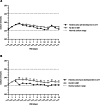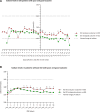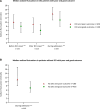Sodium and Its Impact on Outcome After Aneurysmal Subarachnoid Hemorrhage in Patients With and Without Delayed Cerebral Ischemia
- PMID: 38206089
- PMCID: PMC11008454
- DOI: 10.1097/CCM.0000000000006182
Sodium and Its Impact on Outcome After Aneurysmal Subarachnoid Hemorrhage in Patients With and Without Delayed Cerebral Ischemia
Abstract
Objectives: To perform a detailed examination of sodium levels, hyponatremia and sodium fluctuations, and their association with delayed cerebral ischemia (DCI) and poor outcome after aneurysmal subarachnoid hemorrhage (aSAH).
Design: An observational cohort study from a prospective SAH Registry.
Setting: Tertiary referral center focused on SAH treatment in the Amsterdam metropolitan area.
Patients: A total of 964 adult patients with confirmed aSAH were included between 2011 and 2021.
Interventions: None.
Measurements and main results: A total of 277 (29%) developed DCI. Hyponatremia occurred significantly more often in DCI patients compared with no-DCI patients (77% vs. 48%). Sodium levels, hyponatremia, hypernatremia, and sodium fluctuations did not predict DCI. However, higher sodium levels were significantly associated with poor outcome in DCI patients (DCI onset -7, DCI +0, +1, +2, +4, +5, +8, +9 d), and in no-DCI patients (postbleed day 6-10 and 12-14). Also, hypernatremia and greater sodium fluctuations were significantly associated with poor outcome in both DCI and no-DCI patients.
Conclusions: Sodium levels, hyponatremia, and sodium fluctuations were not associated with the occurrence of DCI. However, higher sodium levels, hypernatremia, and greater sodium fluctuations were associated with poor outcome after aSAH irrespective of the presence of DCI. Therefore, sodium levels, even with mild changes in levels, warrant close attention.
Copyright © 2024 The Author(s). Published by Wolters Kluwer Health, Inc. on behalf of the Society of Critical Care Medicine and Wolters Kluwer Health, Inc.
Conflict of interest statement
Dr. Labib disclosed work for hire. The remaining authors have disclosed that they do not have any potential conflicts of interest.
Figures



Similar articles
-
The relation of early hypernatremia with clinical outcome in patients suffering from aneurysmal subarachnoid hemorrhage.Clin Neurol Neurosurg. 2014 Aug;123:164-8. doi: 10.1016/j.clineuro.2014.05.022. Epub 2014 Jun 2. Clin Neurol Neurosurg. 2014. PMID: 24956546 Review.
-
Significance of fluctuations in serum sodium levels following aneurysmal subarachnoid hemorrhage: an exploratory analysis.J Neurosurg. 2018 Aug 17;131(2):420-425. doi: 10.3171/2018.3.JNS173068. Print 2019 Aug 1. J Neurosurg. 2018. PMID: 30117765 Clinical Trial.
-
Toll-like receptor 4 (TLR4) is correlated with delayed cerebral ischemia (DCI) and poor prognosis in aneurysmal subarachnoid hemorrhage.J Neurol Sci. 2015 Dec 15;359(1-2):67-71. doi: 10.1016/j.jns.2015.10.018. Epub 2015 Oct 14. J Neurol Sci. 2015. PMID: 26671088
-
Early and delayed blood-brain barrier permeability predicts delayed cerebral ischemia and outcomes following aneurysmal subarachnoid hemorrhage.Eur Radiol. 2024 Aug;34(8):5287-5296. doi: 10.1007/s00330-023-10571-w. Epub 2024 Jan 15. Eur Radiol. 2024. PMID: 38221580
-
Associations between C-reactive protein and white blood cell count, occurrence of delayed cerebral ischemia and poor outcome following aneurysmal subarachnoid hemorrhage: a systematic review and meta-analysis.Acta Neurol Belg. 2021 Oct;121(5):1311-1324. doi: 10.1007/s13760-020-01496-y. Epub 2021 Jan 9. Acta Neurol Belg. 2021. PMID: 33423218 Free PMC article.
Cited by
-
A prognostic model incorporating the albumin-corrected anion gap in patients with aneurysmal subarachnoid hemorrhage.Front Neurol. 2024 Jun 19;15:1361888. doi: 10.3389/fneur.2024.1361888. eCollection 2024. Front Neurol. 2024. PMID: 38962480 Free PMC article.
-
Leveraging machine learning algorithms to forecast delayed cerebral ischemia following subarachnoid hemorrhage: a systematic review and meta-analysis of 5,115 participants.Neurosurg Rev. 2025 Jan 7;48(1):26. doi: 10.1007/s10143-024-03175-5. Neurosurg Rev. 2025. PMID: 39775123
-
The impact of serum sodium variability on surgical patients with aneurysmal subarachnoid hemorrhage.Neurosurg Rev. 2025 Jan 16;48(1):55. doi: 10.1007/s10143-025-03212-x. Neurosurg Rev. 2025. PMID: 39815113
-
Cerebrospinal fluid analysis and changes over time in patients with subarachnoid hemorrhage: a prospective observational study.J Anesth Analg Crit Care. 2025 Jun 12;5(1):31. doi: 10.1186/s44158-025-00250-1. J Anesth Analg Crit Care. 2025. PMID: 40506779 Free PMC article.
-
Prediction of functional outcomes in aneurysmal subarachnoid hemorrhage using pre-/postoperative noncontrast CT within 3 days of admission.NPJ Digit Med. 2025 Aug 24;8(1):542. doi: 10.1038/s41746-025-01953-z. NPJ Digit Med. 2025. PMID: 40849351 Free PMC article.
References
-
- van Gijn J, Kerr RS, Rinkel GJE: Subarachnoid haemorrhage. Lancet. 2007; 369:306–318 - PubMed
-
- Feigin VL, Lawes CM, Bennett DA, et al. : Worldwide stroke incidence and early case fatality reported in 56 population-based studies: A systematic review. Lancet Neurol. 2009; 8:355–369 - PubMed
-
- Nieuwkamp DJ, Setz LE, Algra A, et al. : Changes in case fatality of aneurysmal subarachnoid haemorrhage over time, according to age, sex, and region: A meta-analysis. Lancet Neurol. 2009; 8:635–642 - PubMed
-
- Al-Khindi T, MacDonald RL, Schweizer TA: Cognitive and functional outcome after aneurysmal subarachnoid hemorrhage. Stroke. 2010; 41:e519–e536 - PubMed
-
- Duan W, Pan Y, Wang C, et al. : Risk factors and clinical impact of delayed cerebral ischemia after aneurysmal subarachnoid hemorrhage: Analysis from the China National Stroke Registry. Neuroepidemiology. 2018; 50:128–136 - PubMed
Publication types
MeSH terms
Substances
LinkOut - more resources
Full Text Sources

